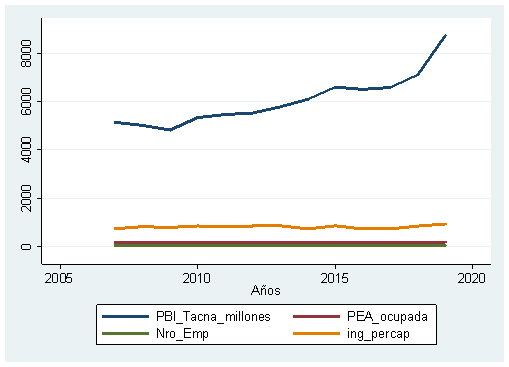Analysis of Zofratacna and its impact on the development of the Tacna region, period 2007 - 2019
DOI:
https://doi.org/10.56926/unaaaciencia.v4i1.94Keywords:
gross, capita, economic, PIBAbstract
ZofraTacna has great tax and customs benefits for companies incorporated within its facilities. However, the true impact of said area on the economy has not been demonstrated. The objective of the study was to analyze the impact of ZofraTacna on the social-economic development of the Tacna Region, using statistical data on GDP, Economically Active Employed Population, Per capita Income and companies installed in the area. The methodology was explanatory and non-experimental, transversal in design. The data collection instruments used were the interview guide and the questionnaire. The statistical test applied corresponded to Pearson and OLS. It was determined that the independent variables influence GDP growth by 80%, highlighting the role of ZOFRATACNA as an economic engine and job generator. However, the region did not achieve adequate development between 2007-2019. Although ZofraTacna has an impact of 77.32% on economic development, the Regional Government of Tacna participates limitedly in its promotion, which restricts the use of available tax and customs benefits. It concludes with the need for more effective strategies to enhance ZofraTacna as a key tool for the sustainable development of the region.
Downloads
References
CEPAL. (2020). Los efectos del COVID-19 en el comercio internacional y la logística. CEPAL. Recuperado de: https://www.cepal.org/es/publicaciones/45877-efectos-covid-19-comercio-internacional-la-logistica DOI: https://doi.org/10.18356/16820908-2020-132-7
ComexPerú. (2022). Zonas francas: ¿han impulsado la competitividad del país? https://www.comexperu.org.pe/articulo/zonas-francas-han-impulsado-la-competitividad-del-pais?utm_source=chatgpt.com
Comité de Administración de ZOFRATACNA. (2019).
Bahl, R., & Linn, J. (2020). Urban Public Finance in Developing Countries. Oxford University Press.
Dilla, H., y Álvarez, C. (2018). Arica/Tacna: Los circuitos económicos de un complejo urbano transfronterizo. Diálogo andino, (57), 99-109. https://dx.doi.org/10.4067/S0719-26812018000300099 DOI: https://doi.org/10.4067/S0719-26812018000300099
Florida, R. (2012). The Rise of the Creative Class. Basic Books. https://paas.org.pl/wp-content/uploads/2016/08/The-Creative-Class-Revisited-FLorida.pdf
Glaeser, E. (2011). Triumph of the City. Business Economics, 46, 185 – 186. doi:10.1057/be.2011.16 DOI: https://doi.org/10.1057/be.2011.16
Guiot, T., Escobar, L., y Gallego, F. (2019). Estudio comparativo del desarrollo económico y social generado por la zona franca de Tacna Perú y el Puerto de Arica Chile. (Tesis de pregrado, Universidad Libre) https://redcol.minciencias.gov.co/Record/RULIBRE2_5f79e27bb2d32f28df46c91a7225744d/
Hausmann, R., Hidalgo, C., Bustos, S., Coscia, M., Simoes, A., & Yildirim, M. (2013). The Atlas of Economic Complexity. MIT Press. https://growthlab.hks.harvard.edu/files/growthlab/files/atlas_2013_part1.pdf DOI: https://doi.org/10.7551/mitpress/9647.001.0001
Hernández Sampieri, R. (2014). Metodología de la Investigación. México: Mc Graw Hill.
Lazaro, I. (2021). Importaciones y su relación con la Producción de las empresas de confección textil de la zona franca de Tacna, periodo 2016-2020. [Tesis de pregrado, Universidad Privada de Tacna] https://repositorio.upt.edu.pe/bitstream/handle/20.500.12969/1806/Lazaro-de-la-Torre-Isabel.pdf?sequence=8&isAllowed=y
Lucero, C. (2023). Análisis comparativo de la competitividad internacional entre ZOFRATACNA y Zona Franca de Bogotá. [Tesis de pregrado, Universidad de Lima] https://repositorio.ulima.edu.pe/bitstream/handle/20.500.12724/19714/T018_71318865_T.pdf?sequence=1&isAllowed=y
Porter, M. E., & Rivkin, J. W. (2012). The Looming Challenge to U.S. Competitiveness. Harvard Business Review.
Stiglitz, J. E., & Greenwald, B. C. (2014). Creating a Learning Society: A New Approach to Growth, Development, and Social Progress. Columbia University Press. Recuperado de: https://www.pc.gov.au/media-speeches/richard-snape-lectures/joseph-stiglitz/snape-2014-stiglitz.pdf DOI: https://doi.org/10.7312/stig15214
Todaro, M. P., & Smith, S. C. (2020). Economic Development. Pearson. Recuperado de: https://students.aiu.edu/submissions/profiles/resources/onlineBook/F5v9e6_Economic%20Development-2020.pdf

Downloads
Published
How to Cite
Issue
Section
License
Copyright (c) 2025 Randyk Jusev Guzman-Meza

This work is licensed under a Creative Commons Attribution 4.0 International License.
The authors retain their rights:
a. The authors retain their trademark and patent rights, as well as any process or procedure described in the article.
b. The authors retain the right to share, copy, distribute, execute and publicly communicate the article published in the scientific journal UNAAACIENCIA-PERÚ (for example, place it in an institutional repository or publish it in a book), with an acknowledgment of its initial publication in UNAAACIENCIA-PERU.
c. Authors retain the right to make a subsequent publication of their work, to use the article or any part of it (for example: a compilation of their works, notes for conferences, thesis, or for a book), provided that they indicate the source. of publication (authors of the work, magazine, volume, number and date).







